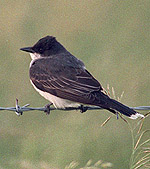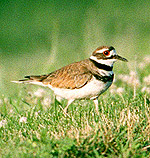

|
All it takes is a drive in the country to see some of these beautiful birds. They live in a variety of habitats, but it is possible to see a majority of them from the car! Many of these birds nest, raise families, hunt for food or hide form predators in large unmowed fields, meadows and ditches. For this reason, it is important that people who live in the country think about reducing the amount and timing of mowing. People move to the country to get away from crowded cities and have a bit of space to themselves. They also like to be close to nature. Unfortunately, people often mow their entire lot, leaving little wildlife habitat. |
Consider leaving sections of the lot in native grasses or wildflowers to support grassland birds like these. Large expanses of mowed turf attract grackles, starlings, cowbirds and other undesirables. Rural lots are often an acre or more in size. That should leave plenty of room for both people and wildlife. Taking our urban and suburban lawns with us to the country further simplifies the available habitat. Scientists use the word "simplify" to describe the process of making all of the habitat the same. A patch of wild flowers and prairie grass will add beauty to your property and reduce the time you spend on that riding mower each week! You will be saving time and wildlife. |
 |
 |
 |
| The dickcissel sings all day long. You can find them in hay fields, weedy patches and prairies. The males have a black bib somewhat like a meadowlark, but the dickcissel is much smaller. They migrate as far as Mexico and South America in winter. | The male American goldfinch wears his bright yellow breeding plumage from mid-April to mid-September. They are found in a variety of habitats including backyards. | Note the white band at the tip of the eastern kingbird's tail. No other Illinois bird has it. They hunt mostly insects from fences overlooking pastures. For more about flycatchers, click here. |
 |
 |
 |
| Eastern bluebirds have been helped by the establishment of "bluebird trails." By erecting a series of bluebird houses, conservationists have been able to replace some of the cavities lost when wooden fence posts and dead trees are removed. | The killdeer is our most common shorebird. They are often seen near roads. The well-known call, "kill deer, kill deer" identifies this bird as it flies away. | The eastern meadowlark is a ground-nesting bird that lives in pastures, fields and cropland. Note the white outer feathers on the tail that are especially visible during flight. |
 |
 |
 |
| If a robin took voice lessons, it might sound as beautiful as the rose-breasted grosbeak. It is a woodland bird, but occurs in residential areas, parks, hedgerows and weedy lots. | The common snipe is found in a variety of wet habitats, even roadside ditches. It probes in the mud with its long bill as it searches mostly for earthworms to eat. | With its constant singing and beautiful blue coloring, it is hard to miss the indigo bunting in summer. They are found along roadsides and in woodland edges. |
 |
 |
 |
| The horned lark (above) and lapland longspur (center photo) are birds of the open countryside. Horned larks prefer agricultural fields and can be seen near roads. | Lapland longspurs are not as common, but are sometimes seen with flocks of horned larks. | Male red-winged blackbirds are easy to distinguish thanks to the bright red wing patch. They are conspicuous in spring as they compete for territories. They eat insects and weed seeds in large quantities. For more about blackbirds, click here. |
Return to Home Page